

The Palazzo Minerbetti is an urban palace building located on Via de Tornabuoni #3 at the corner with Via del Parione, which edges into the Piazza Santa Trinita, Florence, in central Florence, region of Tuscany, Italy.


The Palazzo Minerbetti is an urban palace building located on Via de Tornabuoni #3 at the corner with Via del Parione, which edges into the Piazza Santa Trinita, Florence, in central Florence, region of Tuscany, Italy.
The palace is an assembly of palaces from the 12th and 13th centuries, joined under one family in the 15th century. The corner of the building on Via del Parione has a family heraldic shield. [1]
There are two quoted traditions for the derivation of the Minerbetti, one claims that it derives from a cadet or minor branch of an English Becket family, emigrating prior to the 15th century, perhaps related to the family Saint Thomas Becket of Canterbury, leading to an italianizations of Minor-Becket. [2]
That tradition, however, may be apocryphal; other sources cite this as an ancient republican Florentine family. [3] In 1459, Andrea Minerbetti bought the property from the Bombeni family. [4] The Minerbetti were prominent into the 18th-century, hosting the Grand-Duke of Tuscany with pomp in 1767; by the 1800s, the male line had died. The palace was inherited or sold to the Santini family, then the Buovisi Montecatini of Lucca. [5]
An inn was present at the locale since the 19th century; first, one called Locanda del Pellicano [6] and later Locanda d'Europa. [7] The top floors house the pension Tornabuoni Beacci with a rooftop terrace with a view. [8] [9]
The lower floor of the main facade on Via Tornabuoni has rounded arches and slightly polished stone masonry of varying size. The thin corner building with an iron balcony along Via Parione was completed in the 19th-century and connected parts of the palace. Construction of this terrace and a grand staircase was begun in 1730. In 1761, a chapel was added by Pier Giovanni Fabbroni; was decorated with frescoes and had an altarpiece of Martyrdom of San Tommaso (Thomas Becket) by Giacinto Fabbroni. [10]

Palazzo Spini Ferroni is a large Gothic palace located along Via de' Tornabuoni at the corner of Piazza Santa Trinita, in central Florence, region of Tuscany, Italy. It stands across from the church of Santa Trinita.
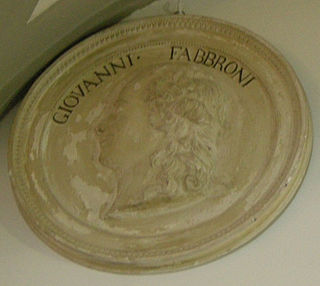
Giovanni Valentino Mattia Fabbroni was an Italian naturalist, economist, agronomist and chemist.
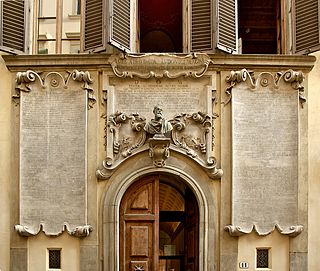
Palazzo dei Cartelloni, also known as Palazzo Viviani, is a Baroque-style palace in Florence, region of Tuscany, Italy.

Via de' Tornabuoni, or Via Tornabuoni, is a street at the center of Florence, Italy, that goes from Antinori square to ponte Santa Trinita, across Santa Trinita square, distinguished by the presence of fashion boutiques.
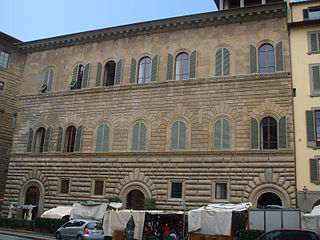
Palazzo Gondi is a palace in Florence, Italy, located a block from Piazza della Signoria. It was built in 1490 under design by Giuliano da Sangallo, who was inspired by other major works of stately buildings in the city, such as Palazzo Medici and Palazzo Strozzi. Among the elements borrowed from these earlier works are the cube-shape set around a central courtyard, the ashlar sloping on each of three floors, and the arched windows.
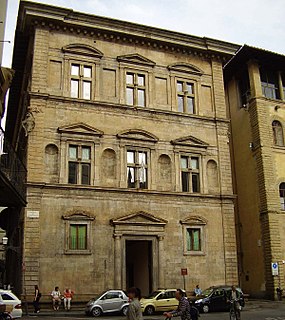
The Palazzo Bartolini Salimbeni is a High Renaissance-style palace located on Via de Tornabuoni on Piazza Trinita in central Florence, Tuscany, Italy.

Palazzo Antinori is a Renaissance palace located at the north end of Via de' Tornabuoni, where it makes an odd corner with Via dei Pecori, Via del Trebbio, and converts into Via dei Rondinelli, in Florence, region of Tuscany, Italy.

The Torre dei Gianfigliazzi is a Romanesque-style medieval tower-residence located on Via de' Tornabuoni #1 in central Florence, region of Tuscany, Italy. It can be seen rising adjacent to the left of the church of Santa Trinita. It now hosts a hotel.
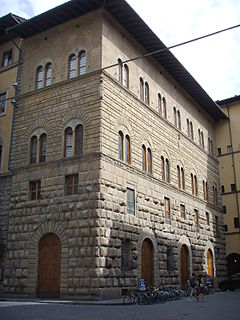
Palazzo dello Strozzino is a Renaissance palace in Florence, region of Tuscany, Italy. The stone Renaissance facade is located on Piazza degli Strozzi, diagonal to the Southeast corner of the imposing Palazzo Strozzi. The Northern façade on Via dei Anselmi houses the entrance to the Cinema Odeon.

The Tower or Torre dei Rossi-Cerchi is a reconstructed medieval tower, now part of the Hotel Pitti Palace al Ponte Vecchio, located on Via Guicciardini, corner Borgo San Jacopo, in the Oltrarno district near the entrance to the Ponte Vecchio in Florence, region of Tuscany, Italy.
The Palazzo del Circolo dell'Unione, also once known across the centuries as the Palazzo Corsi, Montauto, or della Commenda da Castiglione, is a late-Renaissance-style palace located on Via Tornabuoni #7 in central Florence, region of Tuscany, Italy. In 2015, it still houses the Circolo society, and houses among other enterprises, a boutique hotel.
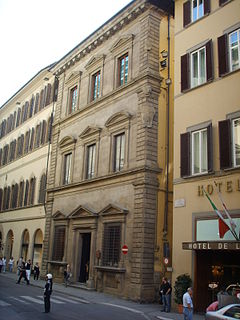
The Palazzo Larderel, once Tebalducci and Giacomini is a Renaissance-style palace, located on Via de' Tornabuoni number 19, corner via de' Giacomini 1, in the city of Florence, region of Tuscany, Italy.

The Palazzo Bartolini-Torrigiani is a palace located between Via Porta Rossa and Via delle Terme, in the city block just west of Piazza Santa Trinita that includes the Palazzo Bartolini Salimbeni, in the center of the city of Florence, region of Tuscany, Italy. This portion of the block includes the medieval Torre dei Monaldi, also known as della Rognosa, rising along Via Porta Rossa.
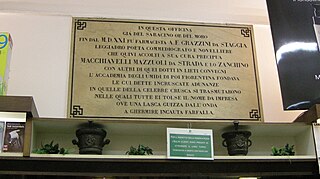
The Farmacia del Moro, also called Farmacia del Saraceno was a pharmacy located facing Piazza San Giovanni and the San Giovanni Battista Baptistry in Florence, region of Tuscany, Italy. The locale originally faced Via Cerretani, facing Canto alla Paglia.

Monastero delle Murate is a former Benedictine convent on Via Ghibellina in Florence, Italy. For about a hundred years, from 1883 to 1985, it was the men's prison in Florence, after which the detainees were transferred to Sollicciano and other facilities. Since the 21st century, it has served as a restaurant and meeting places, with additional apartments, bars, restaurants and shops. The religious community dates to 1370 when 12 women became voluntarily reclusive in a shack by the second pillar of the Ponte Rubaconte, praying and living on alms in extremely difficult conditions. Given the growth in the number of sisters, in 1424, Giovanni de 'Benci, who lived nearby, financed the construction of a new, larger monastery near the walls, called the Most Holy Annunciation and St. Catherine. The monastery was renovated and expanded for the first time in 1471, following a fire, and then in 1571, after a flood. Supporters included Lorenzo de' Medici. Also in 1509 Caterina Sforza was buried in the monastery.

The Reale Museo di Fisica e Storia Naturale was an Italian museum founded on 22 February 1775 in Florence that survived until 1878, when its collections were split up in various Florentine museums.

The Palazzo Compagni or Palazzo Cresci is a palazzo on via Bufalini in Florence.
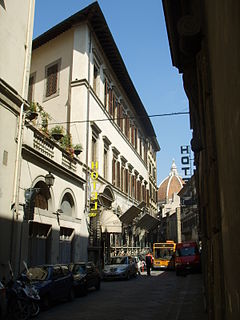
The Palazzo Venturi, once known as Palazzo Doni is a Renaissance-style palace located in central Florence, region of Tuscany, Italy. It located on via de' Banchi 2. The palace differs from the Palazzo Venturi Ginori on Via della Scala.

The Liceo statale "Niccolò Machiavelli" is a high school named after Niccolò Machiavelli located in the historic Oltrarno quarter of Florence, Italy. In the 2020 academic year it offered the secondary schools Liceo classico, Liceo delle Scienze Umane, Liceo Linguistico and Liceo Scientifico. It has a student population of over 1700, making it the second largest high school in the province. Initially based in the Fortezza da Basso, the school was moved Palazzo Rinuccini, in Via S. Spirito, in 2004. The branch of the school housing the international linguistic and international scientific departments is located in Palazzo Frescobaldi, also known as Della Missione. It is one of the oldest Italian normal schools for girls and has hosted the courses of one of the two Royal Higher Education Institutes.

The Palazzina Reale delle Cascine is a small Neoclassical palace sited on the Piazzale delle Cascine within the public park located along the north bank of the Arno river just north of central Florence, Italy. Built in the mid-18th century by the Lorraine Duke of Florence, in 2020 now houses part of the offices of the faculty of agricultural and forestry sciences of the University of Florence.